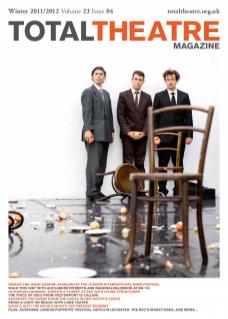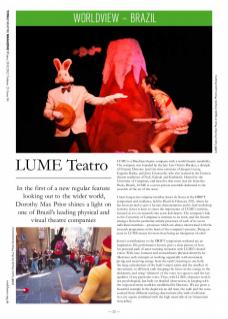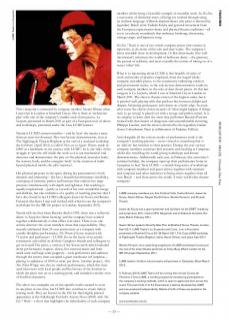LUME is a Brazilian theatre company with a world theatre sensibility. The company was founded by the late Luis Otávio Burnier, a disciple of Etienne Decroux (and one-time associate of Jacques Lecoq, Eugenio Barba, and Jerzy Grotowski) who also trained in the Eastern theatre traditions of Noh, Kabuki and Kathakali. Hosted by the University of Campinas, and based in that town (not far from Sao Paulo, Brazil), LUME is a seven-person ensemble dedicated to the research of the art of the actor.
I meet long-term company member Jesser de Souza at the DRIFT symposium and residency, held in Brazil in February 2011, where he has been invited to give a lecture-demonstration and to lead workshop sessions. Jesser is keen to stress the importance of LUME’s mission, focused as it is on research into actor-led theatre. The company’s link to the University of Campinas is intrinsic to its work, and the theatre emerges from the particular artistic processes of each of its seven individual members – processes which are always intertwined with the research programme at the heart of the company’s practice. Being an actor in LUME means far more than being an interpreter of roles!
Jesser’s contributions to the DRIFT symposium weekend are an inspiration. His performative lecture gives a clear picture of how his personal path of actor training resonates with LUME’s shared vision. With ease, humour and extraordinary physical dexterity he illustrates such concepts as working organically with movement ‘giving and receiving energy from the earth’; learning to use both the large articulations of the body’s major joints and the smallest of movements, to different ends (keeping the focus on the energy in the abdomen); and using ‘vibration’ of the voice in a quest to nail the key qualities of any particular voice. Thus, with LUME, character work is not psychological, but built on detailed observation, in keeping with the corporeal mime tradition established by Decroux. We are given a beautiful example in the depiction an old man, the walk and the voice sourced from different starting observations (the walk of old man in a city square combined with the high nasal talk of an Amazonian storyteller).
This viewpoint is reiterated by company member Naomi Silman when I meet her in London at Stratford Circus. She is there as ‘technician plus’ with one of the company’s smaller-scale clown pieces, La Scarpetta, presented in March 2011 as part of a European tour of shows and workshops, presented under the Casa LUME banner.
Naomi is LUME’s newest member – and by ‘new’ she means a mere thirteen years involvement. Her own lecture-demonstration, seen at The Nightingale Theatre Brighton at the end of a weekend workshop she led there (April 2011), is called There are no Square Flowers, made in 2008 ‘as a landmark on my journey with LUME.’ In it, she talks of the struggle to ‘put the self inside the work so it is not mechanical’ and discusses and demonstrates the play on ‘the physical, muscular body; the sensory body; and the energetic body’ in the creation of multi-layered physical motifs she calls ‘matrices’.
Her physical presence in the space during her presentation is both dynamic and endearing – she has a beautiful performance sensibility, a merging of intensity, pathos and humour that endows her stage presence simultaneously with depth and lightness. Her teaching is equally inspirational – partly as a result of her own wonderful energy and abilities, but also indicative of a quality of teaching practice that I have also found in her LUME colleagues Jesser de Souza and Renato Ferracini (the latter I met and worked with when he ran the company’s workshops for the BR-116 project in London, September 2011).
Naomi tells me that when Burnier died in 1995, there was a collective desire to ‘keep the flame burning’ and the company have worked together collaboratively to that effect ever since. There is no one artistic director: the seven members share that responsibility. They recently celebrated their 25-year anniversary as a company with a multi-discipline performance, The Dream of Icarus, created with 75 artists and performers – LUME live in the heart of an artistic community and called on all their Campinas friends and colleagues to get on board! The piece, a version of the Icarus myth which included street performance, trapeze, clown, live carnival music and both small-scale and large-scale puppetry – took performers and audience through the streets, then occupied a giant warehouse in Campinas – playing to audiences of 1000 or more per show. Another project, Abre Alas (Open Wings), was also an outdoor performance, which this time used interviews with local people and the history of the location in which the piece was set as a starting point, and included a motley crew of bouffon characters.
The above two examples are of site-specific works created to exist in one place at one time, but LUME also continue to create indoor touring work. They are known in the UK for their highly praised appearance at the Edinburgh Festival’s Aurora Nova (2005) with ShiZen 7 Bowls – a show that highlights the individuality of each company member whilst being a beautiful example of ensemble work. In Shi-Zen, a succession of elemental states-of-being are worked through using an intricate language of Butoh-inspired dance (the piece is directed by legendary Butoh artist Tadashi Endo) and gestural movement from the European expressionist dance and physical theatre traditions – all set to an eclectic soundtrack that embraces birdsong, electronica, vintage tango, and Japanese song.
Shi-Zen 7 Bowls is one of two whole-company pieces that remain in repertoire, as do many of the solo and duet works. The company’s latest ensemble show in development, Os Bem Intencionados (‘the well-intentioned’) references the world of ballroom dance – the glamour, the pursuit of celebrity, and most crucially the notion of taking on of a secret ‘other’ life.
What is so interesting about LUME is this breadth of styles of work and modes of practice employed, from the staged whole-company ensemble pieces, to the community-embracing outdoor and processional works, to the solo lecture-demonstration works by each company member, to the solo or duet clown pieces. In this last category is La Scarpetta, which I saw at Stratford Circus London in March 2011. The show is theatre clown of the highest order, but it is painful stuff, playing with that perilous line between delight and despair, balancing grotesquery and charm on a knife-edge. In scene after scene the classic clown scenario of ‘what might happen if things were to go wrong’ is played out with a savage and pitiless intent. It is no surprise to learn after the show that performer Ricardo Puccetti trained with that master of dangerous and uncomfortable clowning, Philippe Gaulier, and the show is directed by the legendary Italian clown Colombaioni Nani (a collaborator of Federico Fellini).
And alongside all the various modes of performance work is the company’s teaching practice – never viewed as something that is an ‘add-on’ but intrinsic to their practice. During the year various company members continue their research and teaching at Campinas whilst also travelling the world giving workshops and lecture demonstrations. Additionally each year, in February (the university’s summer holiday), the company open up their performance home in Campinas to host Terra LUME – a month-long series of workshops with company members and guest artists, together with seminars and symposia and other initiatives to bring artists together from all over Brazil – and from across the world. A truly world-class theatre company!
LUME company members are: Ana Cristina Colla, Carlos Simioni, Jesser de Souza, Naomi Silman, Raquel Scotti Hirson, Renato Ferracini, and Ricardo Pucetti.
Jesser de Souza was a guest presenter and facilitator for the DRIFT residency and symposium 2011, held at CPC Gargarullo and at Aldeia de Arcozelo, Rio state, Brazil, February 2011.
Naomi Silman spoke to Dorothy Max Prior at Stratford Circus Theatre, London, April 2011. LUME Teatro’s La Scarpetta and Cravo, Lirio e Rosa were presented at Stratford Circus 25–26 March 2011. The Casa LUME workshop at Nightingale Theatre Brighton, led by Naomi Silman, took place April 2011.
Renato Ferracini ran a week-long programme of LUME workshops focusing on the role of the street theatre performer at Trinity Buoy Wharf London for the BR-116 project September 2011.
LUME teatro’s Os Bem Intencionados will premiere in Campinas, Brazil March 2010.
In February 2012 LUME Teatro will be running their annual Cursos de Fevereiro e Terra LUME, a monthly programme introducing participants to the company’s working methods, which is open to applicants from across the world. This event links in to the Feverestival, a festival developed by LUME and now produced independently. Details of both of these are posted on the company website.


